I went to the "Meguro parasite pavilion" where you can better understand the mysterious ecology of parasites that can not live without a host

Parasites living parasitically on other animals may have an impression that they are uncomfortable from their appearance, but most of the organisms living on Earth are directly or indirectly involved Parasitism, which is a parasite lifestyle, is one of them. The only research institute in the world specializing in such parasites is "Meguro Parasite HallSo, as I can learn the specimens of parasites that I do not have much opportunity to see and the ecology of mysterious parasites, I actually tried going.
Meguro parasite pavilion official website
http://www.kiseichu.org/Pages/default.aspx
The Meguro parasite pavilion goes out from the West Exit of JR East · Meguro Station and is about 8 minutes walk from Meguro-dori.

Entry fee for the Meguro Parasite Hall is free. As soon as entering the entrance, there is a locker on the right side, it costs 100 yen to use, but it will be returned after use.

As you pass through the entrance door, there is an exhibition space immediately. There is no receptionist.

Meguro parasite pavilion is the exhibition space on the first floor and the second floor.

On the exhibition floor are showcases and ...

Explain the ecology of the parasite using the panel. While watching the panel, you can see the real thing in the showcase. Parasites are classified as parasitic living species, not free living species that live independently without living independently of other species. It is said that form and parasitic style change with evolution, and parasite type is said to be more than free living species.
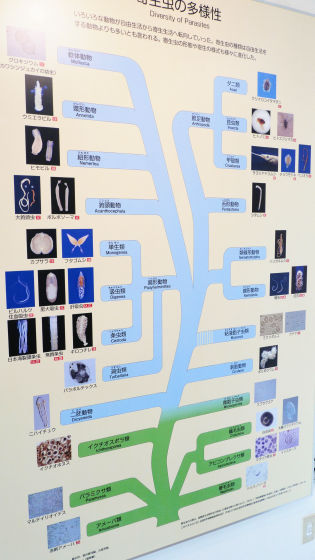
Study parasites on the panel before carefully observing the showcase's parasites. When different kinds of creatures live in the same place, there is a relationship to repel or prey strong seeds, cooperate in good friends, or use other species. Among those relationships, a parasite is a species that lives for a lifetime or for a period of time, by living with other creatures and obtaining nutrition. Creatures that are obsessed by parasites "Host(Parasite) "and parasites may harm the host, but you can not live without a host.
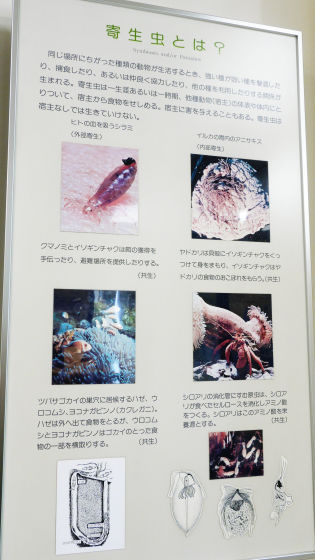
Even parasite, the parasitic style varies by type. Among numerous parasitic styles, representative examples are "lice parasitic on the body surface of many kinds of organisms"External parasitismAnd ...
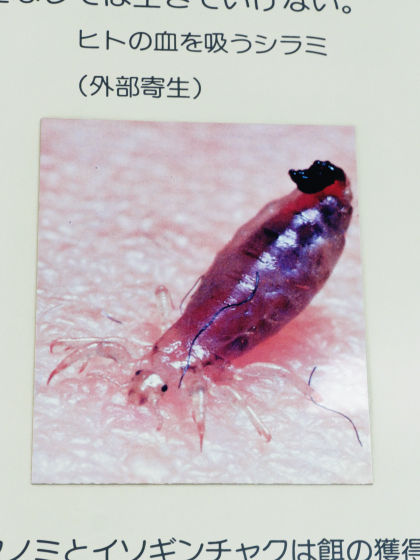
Parasitic in the host bodyAnisakisSuch as "Internal parasitism"is.
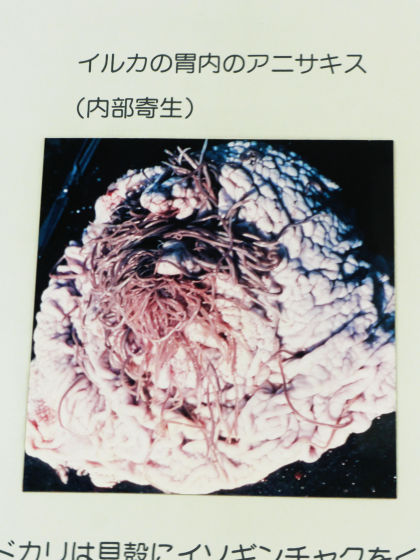
In addition, sea anemones and hermit crabs become symbiotic lifestyle. Hermit crabs protect their bodies by attaching sea anemones to shells, and sea anemones get spilled of hermit crab foods, and each other lives while cooperating.
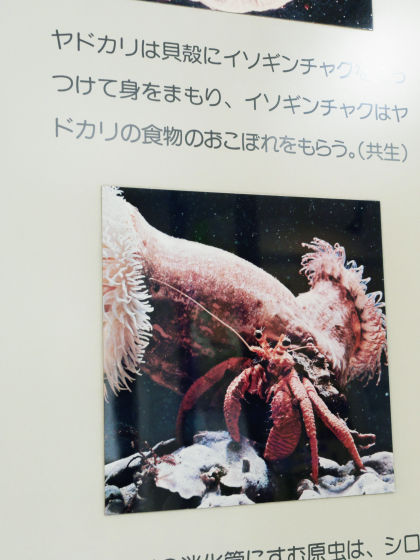
Also, the life history of parasites also varies from type to type. Hosts parasitic to adult parasites are called "Final host", The host infested by the larvae is referred to as"Intermediate host"Between the intermediate host and the final host"Waiting host"There are cases where you need an intermediate host, or you need both an intermediate host and a standby host. The following does not require an intermediate hostGinger wormAn example of life history of. The germinal worms parasitize in the cecum of the person, lay eggs around the anus, adhere to the hand etc and invade the body from the mouth. Eggs hatch in the duodenum and grow into adults in the cecum in several weeks and do not require intermediate hosts.

No intermediate host is requiredUmbrella fowlThe crab parasitized in here is here. The crab is not parasitic on the top, the crab under the parasitic bottom. You can see that parasitized crabs have something like a bag out of the abdomen. Ummon fugromushi adheres to crabs at larval stage and injects cells into crabs using a needle. Cells grow in the body of the crab, absorb the nutrition by roots around the whole body of the crab. When growing, the female reproductive organs of the female beetle breach the crab's belly and reveal its appearance outside the body. The bag on the abdomen of the crab of the image is the reproductive organs of Unmun beetle.
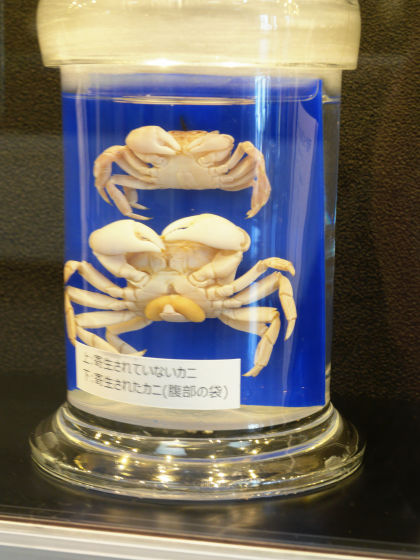
On the other hand, no intermediate host is requiredNoplasswormIn the case of a parasite called hatching in the middle host 's bovine body, grow and proliferate in the body of the person who ate the beef. Also,HepcidiumThere are also types that have life history that grows eggs in the host of the final host, growing in the middle host body like Kanetsu. These are fundamental to the life history of parasites, but there are also types that take more complex life history.

This requires an intermediate hostCat tapewormis. Feline fetuses infect the adults bred eggs in the cat's body and rats eat eggs discharged from the cat. Feline larvae larva hatch in the mouse, cats predispose mice and infect. When the cat predises to the mouse, the larva grows into adults in the small intestine of the cat and produces eggs, and once the rats eat eggs, it becomes the life cycle of the cat animal insects. In the image, the leftmost is the larva of the feline insect larvae, the larvae parasitized in the middle rattle rats, the adult worm at the far right. You can understand the wonders of the ecology of the parasites, cycling only with the end host, parasitizing on the final host via intermediate hosts.
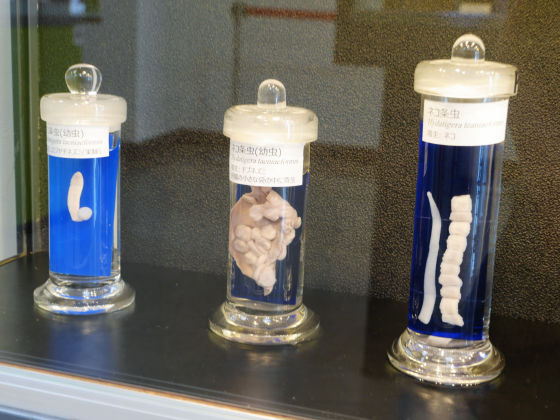
After learning the parasite ecology and lifestyle carefully at the panel, we will look at the showcase where the parasites are displayed in a staggered fashion.

First of all, it is from long and slender filiform nematodes.

Parasitic on pigs and small intestine of humansPorcine roundworm. The roundworm eggs stick to fingers and others, invade the body from the mouth, hatch in the stomach and intestines and become larvae. Later, the larva grows into adults returning to the small intestine through the liver and lungs. They ingest nutrients while parasitizing, they said they will survive 1 to 2 years.

Infests chickens and turkeys, small intestine of peacockChick roundworm. It is a little thinner than a pig's roundworm. In addition, there are 300 animals in the glass bottle of the image.

This is a lion roundworm collected from the lion's intestine. The appearance is not much different from chick roundworm.

Next is a cestode. The parasitic cestodes are elongated and have the same shape as roundworm, but they are sometimes called tapeworm because it is Sanada string.
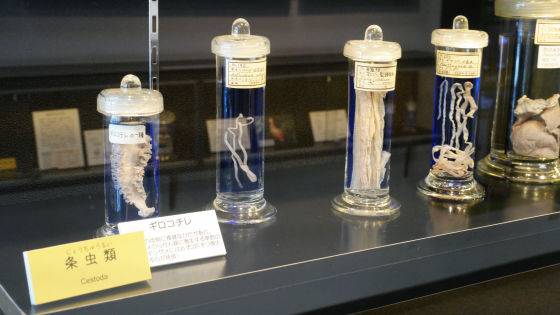
I was infested with a dogManson cleft beetle. The body length of adults is 1 to 2 m and you can see that there are folds in your body. Manson cleft beetle infests parasitic to the final hosts cat, dog, raccoon dog, etc. via the first intermediate host, Kenidomko, the second intermediate host frog / snake.
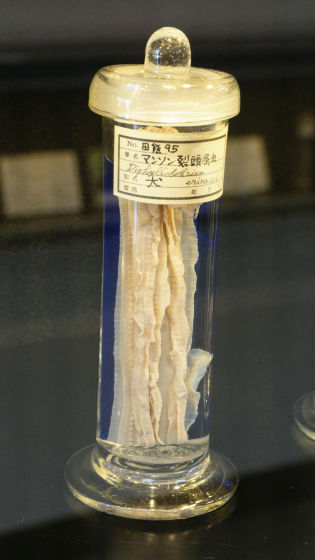
This is a kind of tapewormAlveolar tapewormOf the larvae were infested in bovine liver.
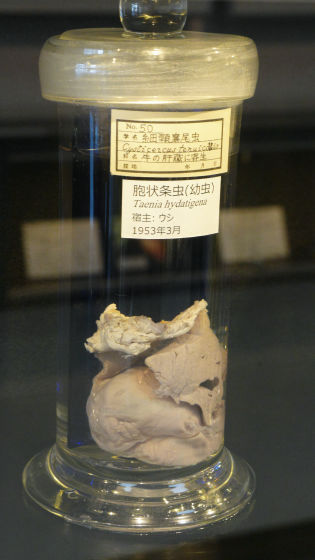
An animal beetle of a whale taken from a whale whale. Although it is said to be a tapeworm, it is interesting that there are many types of parasitic animals, each having a different shape.

A place where larvae of Niberinia parasitic on Taraco, which is a kind of four rostrum (mushroom) caterpillars. There is no fear of health damage because there is nothing to be infested by people.
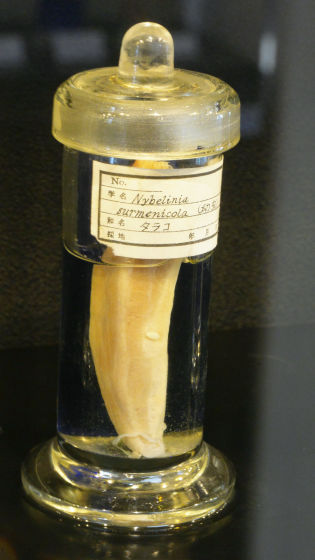
From fish to terrestrial vertebrates, many animals should be the final hostFlukes. It is said that there are kinds of external parasitism and internal parasitism.
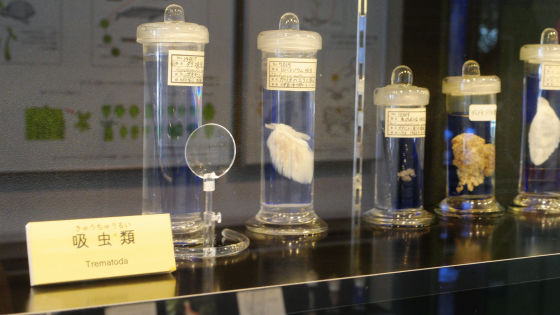
Rovadozoum fluke that was parasitic on the skipjack tuna. You can see the fluke like egg is sticking to the part of Ella.
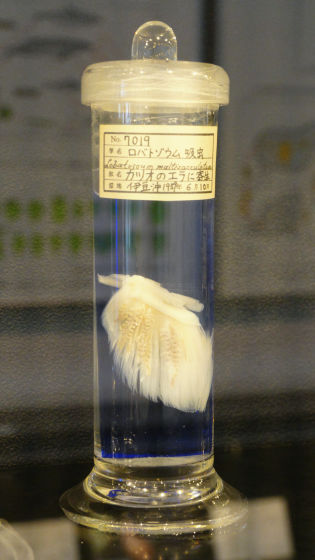
Bimodal parasitic infestation in bovine stomach. The bovine stomach is infested with flukes like white tsubu.

A snout at the head end of the body and a kind of a parasite consisting of an elongated torso following itHookhead bugsis.
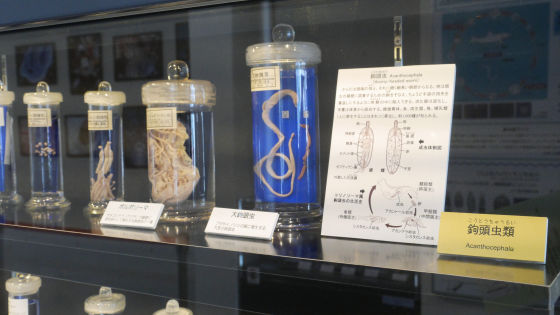
The snout at the head end has a key for securing to the intestinal wall of the host, and it can be put in and taken out. More than 1000 types have been confirmed, but it is unusual to infest the mammals including men. Through intermediate host crustaceans, standby host fish, the final hostpinniped(Chikusukui) to parasitize.
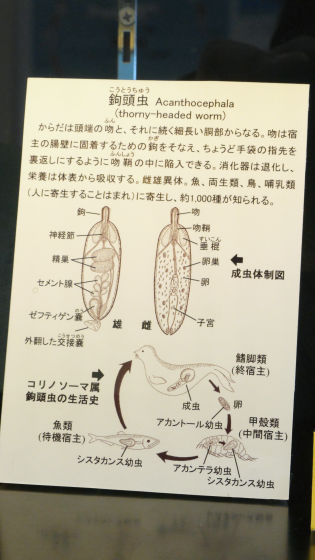
A type of volvosoma parasitic on the intestinal wall of the whale's Okigodendo. You can see that it is infesting with Missiri on the wall.

This is whimpy little one that is parasitic on Sanma, a pinch of insects, a male on the left and a female on the right.
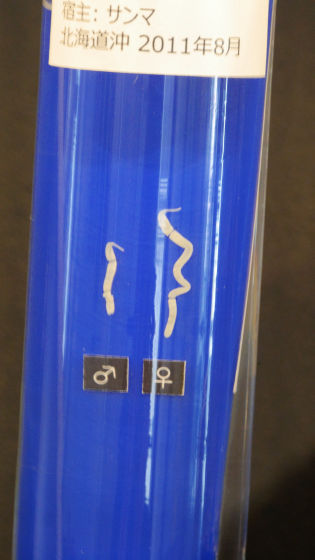
well knownMiteTypes were also exhibited. In the mites it is said that parasites contain ticks and dust mites that exterminate and suck blood.
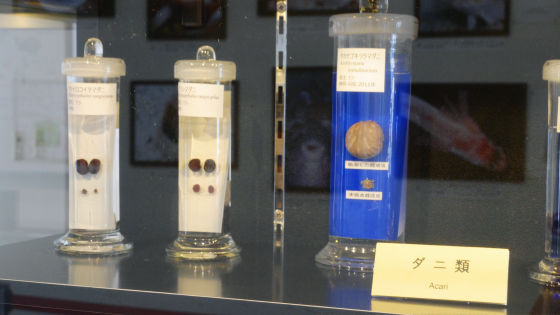
Insects that directly or indirectly harm animals, sometimes called hygiene pestsSanitary insect.
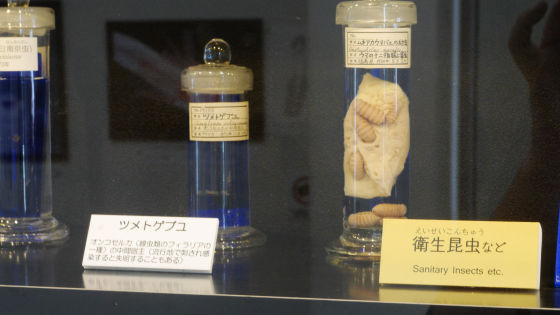
The larva of Muneaca fly parasitized in the duodenum of a horse has a shape like a caterpillar. Actual infestation may cause loss of appetite, malnutrition and gastrointestinal disturbance.
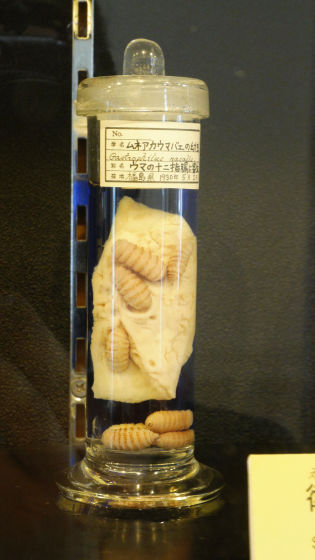
Sayori doraji parasitic on the gill cavity containing the Ella of Sayori. It is said that the body is so large that it gives scratches and compression denaturation to the Ella of Sayori.

On the floor on the first floor, there were also representative parasites among the parasites that parasitize people, and exhibition corners representing parasitic areas. There are over 200 kinds of parasites parasitizing on humans in the world, and over 100 kinds are confirmed in Japan.

I will go to the second floor after finishing the first floor.

On the second floor, "Parasites related to the human body" is displayed.
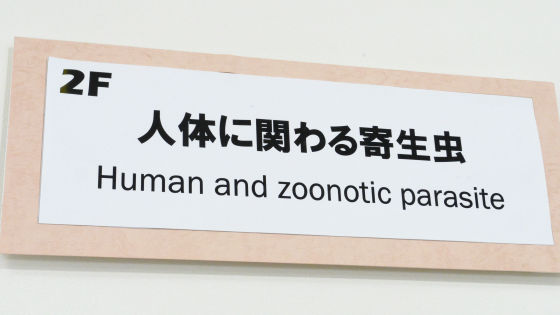
The second floor has more panels than the exhibits.

In the first place, there are about 200 kinds of parasites related to humans, 90% of which are called "zoonotic parasites". The zoonotic common parasite has a life cycle in which wild animals are the original end host, and people say that they will be infested with parasitism. The remaining 10% is a human host parasite, with people as the main host. In Japan, it seems that almost no human parasite is seen due to improvement of sanitary condition and preventive measures.
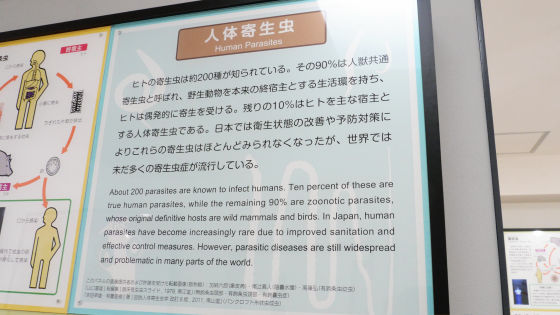
It is widely distributed throughout the world and is Buddhist and Budworm Insects. The majority of human infection is caused by eating cooked incomplete beef and pork in a foreign country. Infested insects parasitize on cattle in intermediate hosts, infecting people from mouth. On the other hand, Staphylococcus aureus infects humans as pigs as intermediate hosts. In the case of Staphylococci, when eggs hatch in the intestine, larvae may migrate to various parts of the body, causing hound arthropodsis, and when the larvae parasitize the brain, it is dangerous and dangerous Thing. Pictures of patients suffering from arthropodsis were also exhibited, but for the tremendous impact, please visit those who want to see by all means.

Bancroft filiform insectIs widely distributed from the temperate zone to the tropical zone of the world, and it was a paradigm that ended by 1970 although it was epidemic in Japan even though it was old in Japan. It grows to third stage larvae in the body of a mosquito and infects people from the skin.
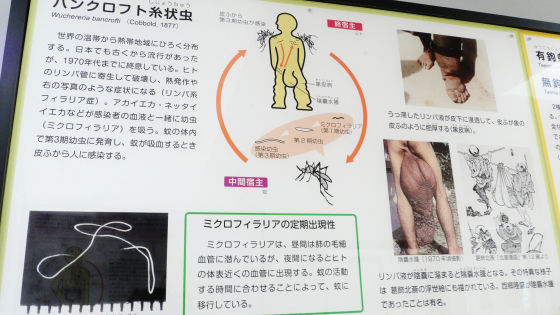
It is the roundworm that has long been known in the world since long ago, and 8 to 1.2 billion people are currently infected. I eat raw eggs with eggs and infect people. Over 80% of people were infested in postwar Japan in which manure was used as fertilizer, but now it seems that it became a rare parasite.
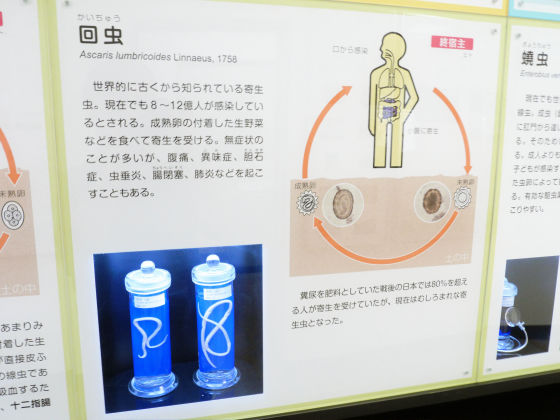
What is reflected in the image below is a roundworm harvested from humans.

It is thought that the roundworm of the image was what the person of Tokyo dispelled, and was surprised.
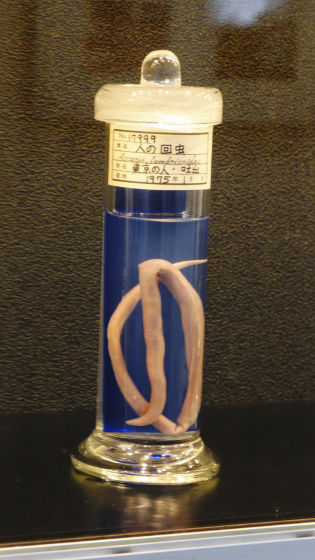
Although I feel a bit nervous when reading explanations on roundworms, the parasite rate of roundworm in Japan sharply declined since 1950, almost 0% since 1975.
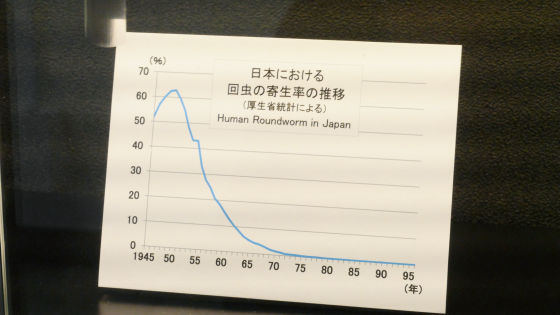
Germinate worms, a type of nematode, are still widely distributed throughout the world, and children are more infested than adults. An adult female about 1 cm long comes out from the anus at night and lay eggs around the anus.

For ginger worms, infection was seen in more than 80% of children, but parasitism rate decreased to less than 1%. Therefore, "ginger worm inspection" using cellophane tape isAbolished as long as 2015It was decided to be done.
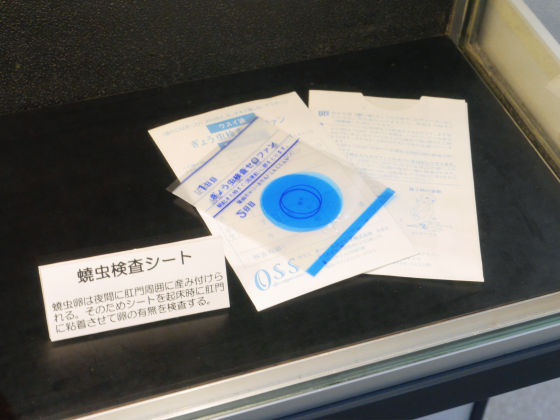
From here we introduce some of the zoonotic common parasites that account for 90% of the parasites related to the human body.Hepcidium(Kanketsu) is a large fluke parasitic to the liver such as cattle and sheep. Upon infection with humans, abdominal abdominal pain and fever,CholelithiasisIt shows symptoms like.
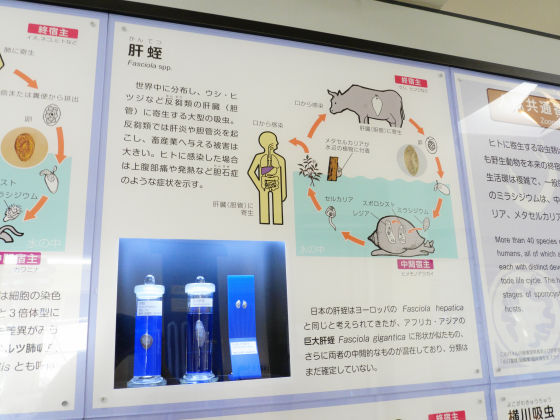
The two on the left are fecal fragments parasitic on cattle. The right is an intermediate host, Mr. Monogatari.
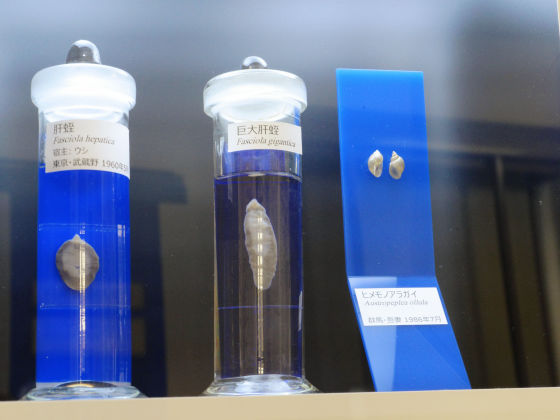
Anisakis is familiar to Japanese who eat marine fish and shellfish. There are about 10 kinds of Genus Anisakis, but mainly larvae parasitizing on Japanese fish and squid are 2 kinds.
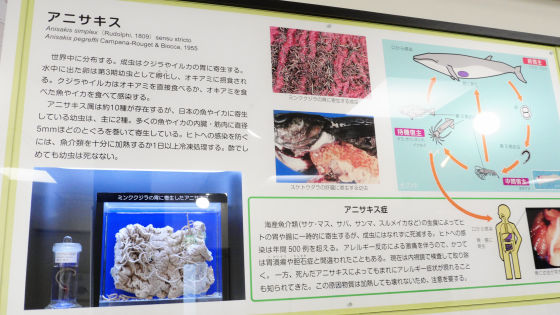
Although it may temporarily infest the human stomach and intestines, it does not become an adult but it will die. There are over 500 reports annually of human infections annually, which is accompanied by severe pain due to allergic reactions.
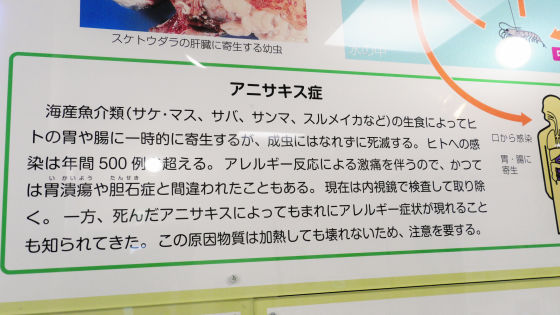
This is the stomach of dolphin parasitic on Anisakis. I know that I do not know how many are parasitic.

Squid, parasitic on larvae of Anisakis.

Here is also a saury which Anisakis larva infested. If you look closely, you can see that there is Anisakis which has been chopped inside the abdomen.

What is known as a dog's filaria is a parasite that is called a dogworm bug. It infests dogs via mosquitoes of intermediate hosts, but it may infest humans from mosquitoes, and if infected it may form a tumor without becoming an adult.

Here is the real thing of a dog's yarn insect. There is a female on the left and a male on the right in the left glass bottle. The right side is the heart of a dog parasitized by a dogworm bug.

Even with the exhibit on the second floor, the first thing to draw is the total length of 8.8 mJapan Sea Fragment Head Tapeworm. It infects end-host human beings and dogs via the first intermediate host, Ken Daphnia, the second intermediate host cherry tree, and colorful mass. The Nihonkai cleavage tapeworm being exhibited is an adult parasitized from humans, infected by eating massive sushi with larvae. Three months after eating mass sushi, part of the tapeworm came out with flights and noticed it. In August 1986 I drunk an anthelmintic and excreted all the bugs. There was no subjective symptoms in the infected person.

The head is thinly ... ...

The body part continues with the group ... ...

Here is the tail. I think that 8.8 m parasites have come out of the body ... ....

The parasite pavilion introduces precautions to prevent from parasitic infection. Freshwater produced fish and shellfish can be boiled or baked well, while those of the sea can be eaten raw, but caution is required for larvae such as Anisakis. Grill beef and pig meat well, wash raw vegetables firmly. Also, after having played with pets etc, or before meals, wash hands thoroughly, and it is important to note water, soil, insects etc. in the endemic areas of parasites infected from the skin.
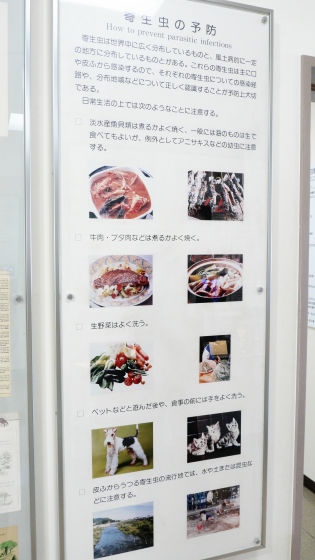
In addition to the parasites on the second floor you can know the history of the establishment of the Meguro parasite pavilion.

It is a famous parasitologist in the worldYamaguchi leftAbout 10,000 specimens collected by Dr. and literature materials are registered and stored in the parasite pavilion.

A duplicate of a preparation slide used by Dr. Yamaguchi. A lot of specimens produced by Dr. Yamaguchi were preserved in the specimen storehouse on the basement floor of the parasite pavilion, and it is still being used for research even though it is still used.

Microscope and drawing device that Dr. Yamaguchi loved. Dr. Yamaguchi studied the morphology of the parasite using this microscope and drawing device, contributed to parasitology by leaving many sketches and papers.

While observing the parasite with a microscope, I used mirrors to draw the parasite shape on the note and draw it.
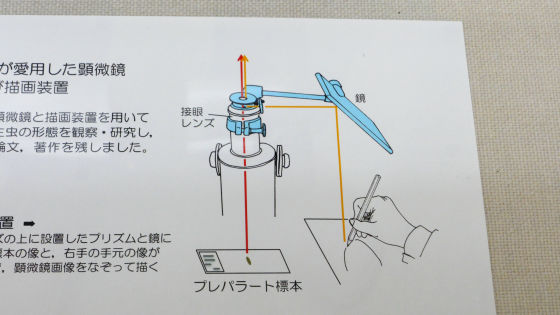
A part of the note "cheat sheet" created by Dr. Yamaguchi. You can see well that it is drawn surprisingly finely.
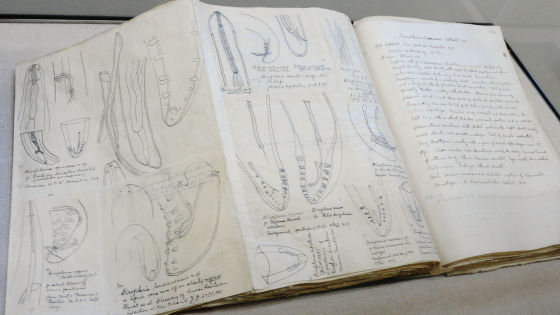
The tour of the Meguro parasite pavilion is over. Meguro parasitic hall is free of entrance fee and can be learned about parasites sufficiently if it takes 45 minutes to 1 hour even if you look carefully. If you are interested, I recommend you visit once.
Related Posts:







